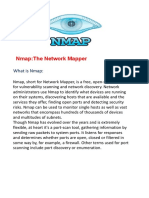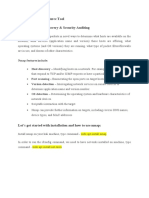0 ratings0% found this document useful (0 votes)
39 viewsNMAP Syntax
The document provides examples of NMAP commands for different scanning purposes. It shows a ping sweep to enumerate hosts on two subnets, a basic SYN scan of a /24 network including service and operating system detection, scans to find unused ports and web applications on multiple segments, targeted scans of specific services like SMTP and TFTP, and useful additional NMAP parameters like custom DNS servers and port lists.
Uploaded by
Prasad DhondCopyright
© Attribution Non-Commercial (BY-NC)
Available Formats
Download as DOC, PDF, TXT or read online on Scribd
0 ratings0% found this document useful (0 votes)
39 viewsNMAP Syntax
The document provides examples of NMAP commands for different scanning purposes. It shows a ping sweep to enumerate hosts on two subnets, a basic SYN scan of a /24 network including service and operating system detection, scans to find unused ports and web applications on multiple segments, targeted scans of specific services like SMTP and TFTP, and useful additional NMAP parameters like custom DNS servers and port lists.
Uploaded by
Prasad DhondCopyright
© Attribution Non-Commercial (BY-NC)
Available Formats
Download as DOC, PDF, TXT or read online on Scribd
You are on page 1/ 2
NMAP syntax
Here are some NMAP commands I use often.
Enumerating the hosts on a couple of segments
nmap -sP -oA hostlist.active 192.168.1.0/24,172.16.20.0/24
This does a PING sweep in order.
-R makes it do a reverse DNS lookup for every address, whether a host is up or
not.
A basic SYN scan of a slash 24
nmap -sS -T4 -vv -r -sV -O -n -F -oA test208 208.22.79.*
-F makes it faster by skipping most of the default ports.
-r makes it scan the ports in order.
-sV detects service versions.
-O detects OS versions.
A SYN scan to look for useless services on a bunch of
segments
nmap -sS -PN -T4 -oA echochargentest -p T:7,19 -v -r
172.16.20,21,22,5,6,7,16.*
nmap -sS -PN -T4 -oA testsmallservices -p T:7,9,13,17,19,U:7,9,13,17,19 -v -r
192.168.1.*
-PN tells it not to PING first, just check for the open ports.
Looking for web applications
nmap -PN -sT -A -p T:80,443,8080,8888,8088 -oA webapps -T4 192.168.1,2.*
Looking for certain specific services
nmap -sS -sV -PN -T4 -oA testsmtp -p T:25 -v -r 192.168.1.*
nmap -sU -sV -PN -T4 -oA tftptest -p U:69 -v -r 192.168.1.*
nmap -sSU -sV -PN -T4 -oA tftptest -p T:25,U:69 -v -r 192.168.1.*
-sS does a SYN scan; -sU does a UDP scan.
-sV does version detection.
Useful additional parameters
--dns-servers [,[,...]]
Specify your own DNS servers to use as resolvers for reverse queries
-p U:53,111,137,T:21-25,80,139,8080
Specify a list of UDP and TCP ports to scan
--version-trace
Print out extensive debugging info about what version scanning is doing.
-oN
Normal output.
-oG
Grepable output. Prints: Host, Ports, Protocols, Ignored State, OS, Seq Index, IP ID, and
Status.
You might also like
- NMAP Commands Cheat Sheet and Tutorial With Examples (Download PDF100% (2)NMAP Commands Cheat Sheet and Tutorial With Examples (Download PDF10 pages
- Nmap Openssl Snmpget-Walk Ldapsearch Dig Cisco IOS Tcpdump Ssldump Iptables NC (Netcat) Ruby Mysql-OnE LINERSNo ratings yetNmap Openssl Snmpget-Walk Ldapsearch Dig Cisco IOS Tcpdump Ssldump Iptables NC (Netcat) Ruby Mysql-OnE LINERS48 pages
- Experiment - 1: #1: Scan A Single Host or An Ip Address (Ipv4)No ratings yetExperiment - 1: #1: Scan A Single Host or An Ip Address (Ipv4)17 pages
- Network Mapper: Week 2 Application Information Assurance and Security 2No ratings yetNetwork Mapper: Week 2 Application Information Assurance and Security 218 pages
- Top 16 Nmap Commands To Scan Remote HostsNo ratings yetTop 16 Nmap Commands To Scan Remote Hosts10 pages
- Nmap NetworkVulnerabilityAssessment and PenetrationTesting 1706874673No ratings yetNmap NetworkVulnerabilityAssessment and PenetrationTesting 17068746735 pages
- Nmap Cheat Sheet: Target Specification Scan TechniquesNo ratings yetNmap Cheat Sheet: Target Specification Scan Techniques6 pages
- Learning Nmap: The Basics: Rajesh Deodhar How-Tos Tools / Apps 1 CommentNo ratings yetLearning Nmap: The Basics: Rajesh Deodhar How-Tos Tools / Apps 1 Comment5 pages
- FALLSEM2024-25_CSE3501_ELA_VL2024250103033_2024-08-19_Reference-Material-I (1)No ratings yetFALLSEM2024-25_CSE3501_ELA_VL2024250103033_2024-08-19_Reference-Material-I (1)9 pages
- NMAP Commands Cheat Sheet and Tutorial With ExamplesNo ratings yetNMAP Commands Cheat Sheet and Tutorial With Examples21 pages
- Nmap Training Course Is Aimed at Beginners With Limited Nmap Knowledge and Experience. After Taking Our 90-Minute Live Online Class, You'll Have More100% (1)Nmap Training Course Is Aimed at Beginners With Limited Nmap Knowledge and Experience. After Taking Our 90-Minute Live Online Class, You'll Have More1 page
- Nmap Cheat Sheet From Discovery To Exploits - Part 1 Introduction To NmapNo ratings yetNmap Cheat Sheet From Discovery To Exploits - Part 1 Introduction To Nmap19 pages
- bfc594ec-3463-447b-9a99-04426014f14e_N-MapNo ratings yetbfc594ec-3463-447b-9a99-04426014f14e_N-Map5 pages
- Nmap (Network Mapper) is a powerful open-source tool used for network discovery, security auditing, and vulnerability scanningNo ratings yetNmap (Network Mapper) is a powerful open-source tool used for network discovery, security auditing, and vulnerability scanning3 pages
- CISCO PACKET TRACER LABS: Best practice of configuring or troubleshooting NetworkFrom EverandCISCO PACKET TRACER LABS: Best practice of configuring or troubleshooting NetworkNo ratings yet
- LEARN MPLS FROM SCRATCH PART-B: A Beginners guide to next level of networkingFrom EverandLEARN MPLS FROM SCRATCH PART-B: A Beginners guide to next level of networkingNo ratings yet
- ROUTING INFORMATION PROTOCOL: RIP DYNAMIC ROUTING LAB CONFIGURATIONFrom EverandROUTING INFORMATION PROTOCOL: RIP DYNAMIC ROUTING LAB CONFIGURATIONNo ratings yet
- Network with Practical Labs Configuration: Step by Step configuration of Router and Switch configurationFrom EverandNetwork with Practical Labs Configuration: Step by Step configuration of Router and Switch configurationNo ratings yet
- WAN TECHNOLOGY FRAME-RELAY: An Expert's Handbook of Navigating Frame Relay NetworksFrom EverandWAN TECHNOLOGY FRAME-RELAY: An Expert's Handbook of Navigating Frame Relay NetworksNo ratings yet



























































